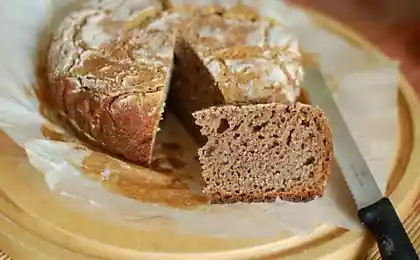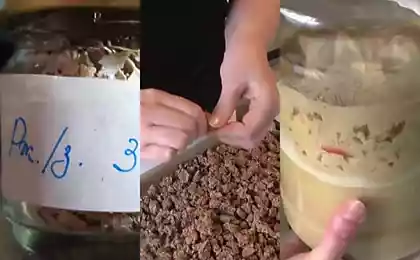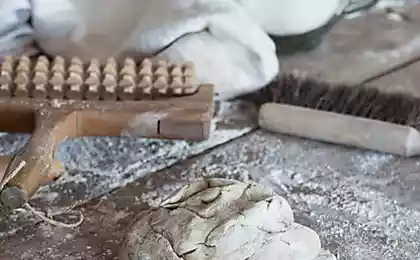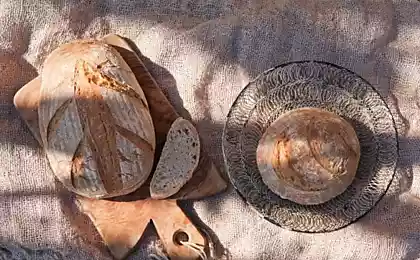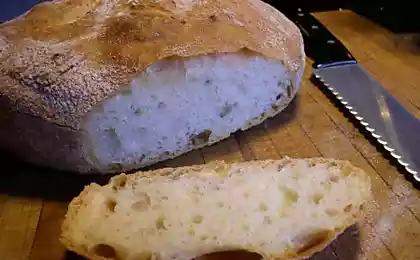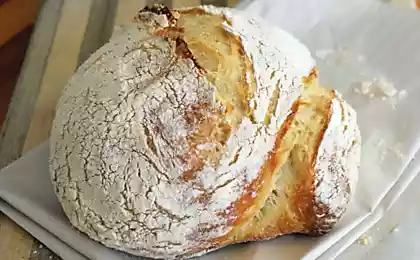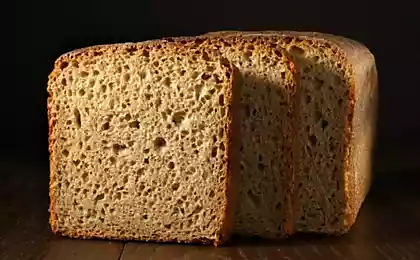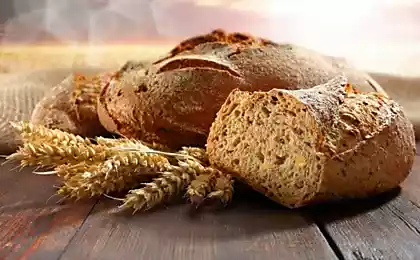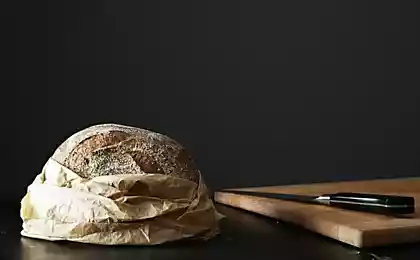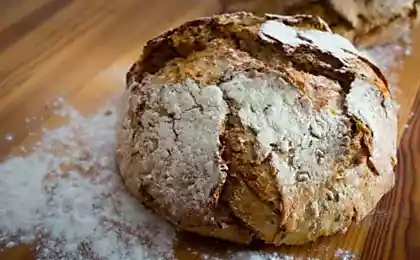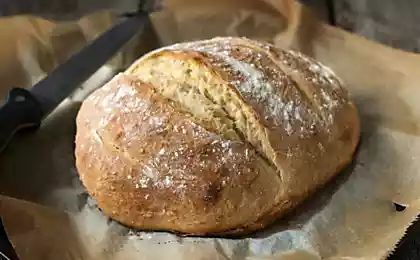514
The recipe for the perfect sourdough bread
Yeast-free sourdoughBread starter is a sourdough based on flour and water, sometimes and other ingredients based on dairy fermentation. Sourdough is used for baking of bakery products and replaces the pressed brewer's yeast.
I'm not going to write about the usefulness of sourdough, but I will say that the bread on it, definitely perfect for the human body. Provided that flour quality, of course. And there can be a lot to write, but it is quite a complex and big topic.
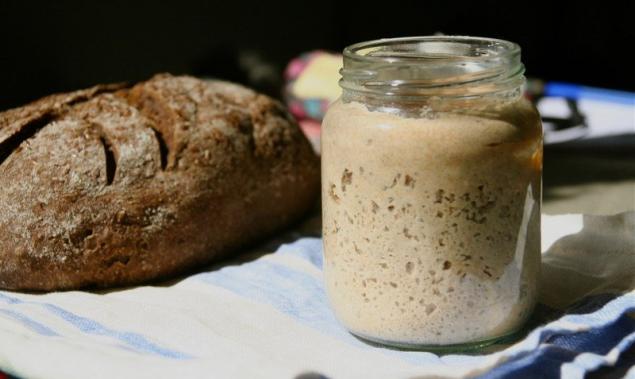
We have a bread baking does my husband, as I believe that he has talent, he loves the dough and even it is the first bread was incredibly delicious. So everything here is written based on our experience.
Composition:
1. Flour. In order to create a first starter it is desirable to have strong flour (type Manitoba)i.e. flour with high protein content.
2. Water. It is ideal to use carbonated water, is not rich content of mineral salts.
3. Other ingredients. To enhance fermentation, most often used for yogurt, olive oil, cold pressed, honey, ripe fruit or vegetables.
I'll write about how we did the leaven that has been living for more than 3 years:
2. Bowl, close with cling film so the dough doesn't dry out. Put the bowl of starter in a dark and warm place (26-28). Very important stable and accurate temperature, be careful. If you have a normal oven (and the baking of bread requires the presence of a normal oven, which is heated to 250 C), you can turn on the light and put a bowl of water in the oven. The water in the bowl should be at least 4 times more than test, and it is important that the dough is "rolled", i.e. was under water.
3. After 48 hours the dough will float to the surface of the water and this means that the fermentation process in the dough is. If the starter starts to ferment, you will have to start all over again.
4. It is possible that it will emerge sooner, then proceed to the next stage.
5. That is, again, knead all the ingredients, and the old "dead" dough throw.
6. If the starter has started to "live", you need to start feeding and to do it every 24 hours.
Fertilizing:
Deal 100 g of your starter, 100 g sifted flour 50 g plain bottled water. In a bowl pour water, add yeast and whisk stir until smooth. Add the flour and knead the dough for 5-10 minutes. Fold the dough in clean glass jar with a screw lid and place in warm (24-26 C), dark place for 24 hours. After 24 hours, repeat.
The Bank should be narrow and clean.
It is important to do the dressing every 24 hours during the week and to control the ripening process using always the same amount of flour and water.
Sometimes, high humidity and type of flour can affect the texture of the dough. That is, it will be too liquid or too dense. First, you will be quite difficult to understand what should be the starter, but with time you learn to feel it.
Meantime, follow the proportions in the recipe.
What to do with the leftover dough?
If a pity to throw, you can use for flipping pancakes and flapjacks. We baked bread the first week, until the starter has matured. The more often you will be fed, the better it will work and the better your bread. In our experience need to feed every two to three days. And, accordingly, to bake bread, if possible.
Disappear if this sour sharp flavor of sourdough?
Yes, disappear over time and appear pleasant, with a slight acidity.
What to do if the yeast slowly Matures?
You can in the early stages to add 1/2 tsp of acacia honey at the time of feeding. This will enhance the fermentation process.
How to store Mature ready starter?
1. In a glass jar with a screw cap at room temperature;
2. If you are going to leave for a week. After feeding, the starter should stand at room temperature for 2 hours and then can put it in the fridge for a week. No more.
3. Before feeding need to take out of the fridge the yeast and leave for 2 hours at room temperature.
Photo of the starter before feeding
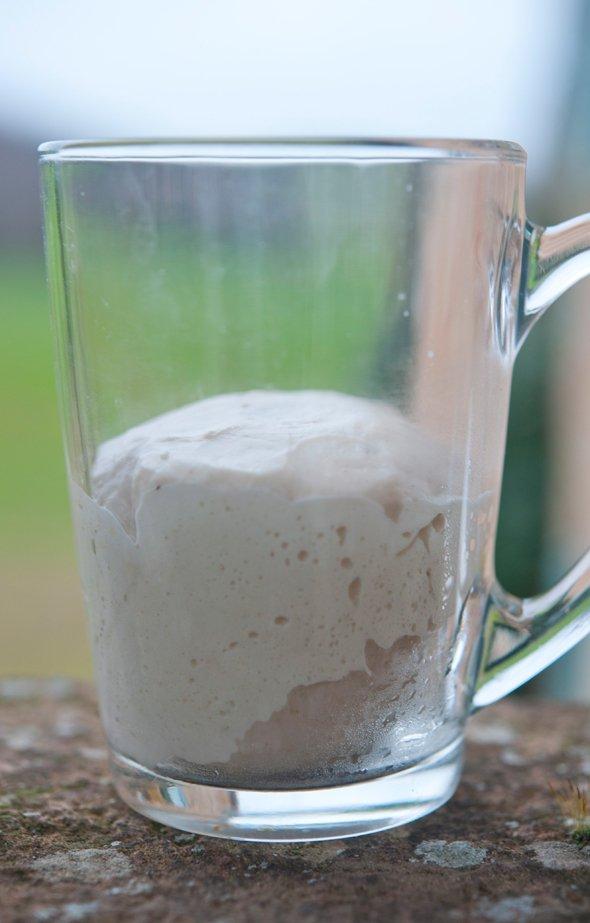
Photo of the starter after feeding

Cook with love!
Author: Ella Martino
P. S. And remember, only by changing their consumption - together we change the world! ©
Source: www.ellamartino.ru/ru/products/hlebnaya-zakvaskalievito-madre
I'm not going to write about the usefulness of sourdough, but I will say that the bread on it, definitely perfect for the human body. Provided that flour quality, of course. And there can be a lot to write, but it is quite a complex and big topic.

We have a bread baking does my husband, as I believe that he has talent, he loves the dough and even it is the first bread was incredibly delicious. So everything here is written based on our experience.
Composition:
1. Flour. In order to create a first starter it is desirable to have strong flour (type Manitoba)i.e. flour with high protein content.
2. Water. It is ideal to use carbonated water, is not rich content of mineral salts.
3. Other ingredients. To enhance fermentation, most often used for yogurt, olive oil, cold pressed, honey, ripe fruit or vegetables.
I'll write about how we did the leaven that has been living for more than 3 years:
- 100 g of ripe fruit (bananas, grape juice, plum puree, etc., your choice)
- 200 g enhanced sifted flour soft wheat varieties (preferably 380 W)
- 50 g of soda water
2. Bowl, close with cling film so the dough doesn't dry out. Put the bowl of starter in a dark and warm place (26-28). Very important stable and accurate temperature, be careful. If you have a normal oven (and the baking of bread requires the presence of a normal oven, which is heated to 250 C), you can turn on the light and put a bowl of water in the oven. The water in the bowl should be at least 4 times more than test, and it is important that the dough is "rolled", i.e. was under water.
3. After 48 hours the dough will float to the surface of the water and this means that the fermentation process in the dough is. If the starter starts to ferment, you will have to start all over again.
4. It is possible that it will emerge sooner, then proceed to the next stage.
5. That is, again, knead all the ingredients, and the old "dead" dough throw.
6. If the starter has started to "live", you need to start feeding and to do it every 24 hours.
Fertilizing:
Deal 100 g of your starter, 100 g sifted flour 50 g plain bottled water. In a bowl pour water, add yeast and whisk stir until smooth. Add the flour and knead the dough for 5-10 minutes. Fold the dough in clean glass jar with a screw lid and place in warm (24-26 C), dark place for 24 hours. After 24 hours, repeat.
The Bank should be narrow and clean.
It is important to do the dressing every 24 hours during the week and to control the ripening process using always the same amount of flour and water.
Sometimes, high humidity and type of flour can affect the texture of the dough. That is, it will be too liquid or too dense. First, you will be quite difficult to understand what should be the starter, but with time you learn to feel it.
Meantime, follow the proportions in the recipe.
What to do with the leftover dough?
If a pity to throw, you can use for flipping pancakes and flapjacks. We baked bread the first week, until the starter has matured. The more often you will be fed, the better it will work and the better your bread. In our experience need to feed every two to three days. And, accordingly, to bake bread, if possible.
Disappear if this sour sharp flavor of sourdough?
Yes, disappear over time and appear pleasant, with a slight acidity.
What to do if the yeast slowly Matures?
You can in the early stages to add 1/2 tsp of acacia honey at the time of feeding. This will enhance the fermentation process.
How to store Mature ready starter?
1. In a glass jar with a screw cap at room temperature;
2. If you are going to leave for a week. After feeding, the starter should stand at room temperature for 2 hours and then can put it in the fridge for a week. No more.
3. Before feeding need to take out of the fridge the yeast and leave for 2 hours at room temperature.
Photo of the starter before feeding

Photo of the starter after feeding

Cook with love!
Author: Ella Martino
P. S. And remember, only by changing their consumption - together we change the world! ©
Source: www.ellamartino.ru/ru/products/hlebnaya-zakvaskalievito-madre
